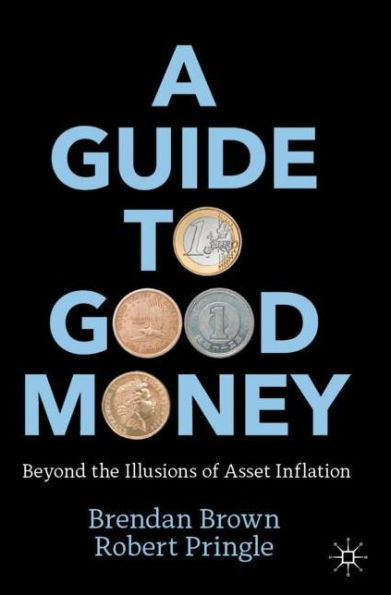
A Guide to Good Money: Beyond the Illusions of Asset Inflation
283
A Guide to Good Money: Beyond the Illusions of Asset Inflation
283Paperback(1st ed. 2022)
-
PICK UP IN STORECheck Availability at Nearby Stores
Available within 2 business hours
Related collections and offers
Overview
This book presents how modern money works both in the domestic economy and globally, outlining the essence of what makes good money. How does modern money differ from this ideal? By focusing on the dichotomy between globalization on the one hand and modern money’s base in the nation state (or group of states) on the other hand, the book demonstrates how US dominance in determining monetary conditions globally has grown since the mid-1990s. The book then discusses the adverse consequences, many of which are camouflaged, of present money doctrines now so widely and radically applied, presenting novel research on how the US by pursuing bad monetary policies has been the catalyst to deepening geo-political danger.
The book continues by setting out how the illusions of asset inflation will fade, most likely in the midst of economic and financial tumult. The forces which bring about that income emanate in part from the long-run costs of growing mal-investment and monopolization which occur under monetary inflation especially in the context of a digitalization revolution. Apologists for the present monetary regime rest much of their case on these illusions and on the contention that the bill for the costs comes only in the long run. This book dismantles that case. A Guide to Good Money provides readers with the sight of a pathway to a promised land of real prosperity founded on sound money beyond those lost illusions, and will be of interest to academics, students, practitioners, and central bankers.

Product Details
| ISBN-13: | 9783031060403 |
|---|---|
| Publisher: | Springer International Publishing |
| Publication date: | 09/01/2022 |
| Edition description: | 1st ed. 2022 |
| Pages: | 283 |
| Product dimensions: | 6.10(w) x 9.25(h) x (d) |
About the Author
Robert Pringle is an author, editor, commentator and entrepreneur specializing in money, banking and capital markets. A former Editor of The Banker, London, he was the first director of the Group of 30 institute on monetary affairs now based in Washington, DC. In 1990 he founded Central Banking Publications, a financial publisher specialising in public policy and financial markets and remains chairman. Robert has monitored and commented on changes in financial markets and the monetary policies of central banks around the world for more than 40 years. He has published several books and edited more than 50 volumes of collected papers, surveys and training manuals for policy makers and market regulators. He holds an MA in economics from King’s College, Cambridge University, UK.
Table of Contents
Introduction.- PART 1: THE PRESENT SCENE.- 1 Modern money - a matter of trust.- 2 Globalization without global money.- 3. The global menace of US monetary policies.- PART TWO: THE ESSENCE OF GOOD MONEY.- 4. What we mean by “good money”.- 5. Why good money has a solid anchor.- PART THREE: THE GRIP OF BAD MONEY.- 6. Asset inflation and the illusions of prosperity.- 7: Exposing the state concept of money.- 8. A short history of modern money.- 9. Symptoms and consequences of bad money.- PART FOUR: VESTED INTERESTS, POLITICS AND THE PANDEMIC.- 10: What keeps a bad system in power?.- 11. Bad money’s pyrrhic victory over the pandemic.- PART FIVE: REFORM, IDEALISM AND PROSPERITY.- 12. Two real anchors.- 13. We reply to potential questions and criticisms.- 14. Pathways to good money.- 15. Criticism, realism, idealism and reform.What People are Saying About This
“Brendan Brown and Robert Pringle target a wide audience of interested, but not necessarily economics-trained, readers. They explain in the clearest possible terms why money matters to all of us. We should want ‘good money’ (stable and reliable) and understand how poor quality money (inflationary and unstable) appears—generally through ignorance, ineptitude, or weakness on the part of the monetary authorities. The deficiencies in the framework and the tools (of deposit insurance, or the ‘too-big-to-fail doctrine, or the use/abuse of the lender-of-last-resort function) have all contributed to our loss of ‘good money’. The consequences are always damaging and can be devastating. But they could be avoided. If only policy makers would listen—to Brown and Pringle.”
—Forrest Capie, Bayes Business School, City, University of London, UK
“Will the runaway inflation of 2021-22 bring to an end the inflationist ‘2% forever’ monetary theory and current central bank dogma? Brendan Brown and Robert Pringle give us a provocative conceptual, historical, and prospective discussion of how a ‘good money’ regime would operate and how it might replace the distortions of the reigning practice of perpetual monetary depreciation. Good money needs a robust ‘anchor,’ they argue, and examine alternative anchors, including a serious discussion of the role of gold and other options. They realistically recognize that there is no perfect solution, and explore relative weaknesses and advantages of monetary alternatives. As Brown and Pringle say, ‘The bad money establishment...has evidently [I would say 'obviously'] failed in the case of the pandemic inflation.’ Now is a perfect time for such fundamental thinking about a better monetary regime.”
—Alex J. Pollock, Senior Fellow, Mises Institute, USA
